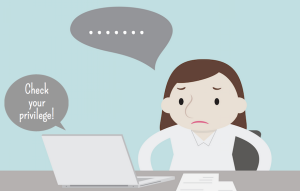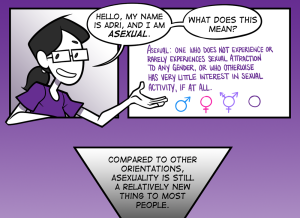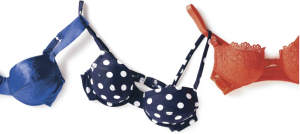Author’s Note: In this piece, I use the phrase “black culture.” This phrase can imply a whole host of things. Literally, it refers to the vast and diverse reality of black cultural experiences – something that’s almost unknowable. For this article, however, “black culture” is used largely in a reductive way to refer to the condensed, packaged version of “culture” made for mainstream consumption.
A few weeks ago, I invited some friends over to watch movies.
With underwhelming Netflix options, someone suggested the old home videos I’d recently gotten from my brother. And as the footage rolled, we giggled at the usual childhood nudity and fast-forwarded through some terribly boring performances.
And then we stumbled across a class project I had long ago stuffed into my subconscious.
It was me: I was 11 years old, leaning back in a lawn chair in my living room wearing a Tupac T-shirt and a backwards cap. The Bone Thugs N Harmony playing in the background faded as I grabbed a tinfoil microphone and, speaking in a terribly offensive black vernacular (also known as AAVE), welcomed the viewer to this episode of Beach MTV, in which we’d be talking about classical music.
I shut it off.
Sitting among my friends, both people of color and white people, many of whom are engaged in social justice work, I was horrified.
My act – call it innocent, call it misguided, call it whatever you want – was undoubtedly a version of modern day blackface.
Who was this 11-year-old me? At the time, I would’ve told you I loved hip-hop and was performing a culture I admired. I probably would’ve recited Left Eye’s rap from “Waterfalls” for you as proof.
I would’ve shared that I loved cultures different from my own and was proudly against racism of all kinds.
But I didn’t actually know any black folks.
No friends, no classmates, no teachers, no neighbors. I didn’t know about capitalism or white supremacy. And I certainly wasn’t engaged in resisting racism, consciously or otherwise.
I had no idea about Tupac or Eazy E’s lived experiences. Nor was I trying to learn about them.
Now, I share that story not because I’m proud, nor because I want to publicly shame myself to feel better. I share it because it isn’t just me, and it isn’t just 11-year-olds.
White people who consume, appropriate, and perform black culture solely for entertainment is a thing.
But reducing black culture to a soundtrack for white entertainment is not an anti-racist thing. Anti-racism isn’t a byproduct of your musical tastes.
There’s that response that floats around: Imitation is flattery.
Sure…
Unless you’re Marvin Gaye and aren’t alive to enjoy the royalties amassed by Robin Thicke’s use of your song.
Unless you’re witnessing Blue Ivy be shamed for her hair while scrolling the Instagrams of white girls hashtagged with “#TeamNatural”.
Unless you’re listening to Iggy rap about crack rocks while the criminal justice system upends your community.
Unless you’re watching white cultural commentators declare “bae” to be “over.”
Unless you’re unable to afford the greens and grits at the new, white-owned, farm-to-table restaurant in your historically black neighborhood.
Unless you’re Tony Robinson or Tamir Rice or Michael Brown and unable to sing along to “99 Problems” with the white folks at Tau Kappa Epsilon’s MLK Black Party.
Far from challenging racism, in reality, the exploitation, appropriation, and consumption of black culture for entertainment has supported white supremacy throughout American history.
Minstrelsy, Blackface, and Other Exploitative Entertainment
White exploitation of black culture for entertainment isn’t new. It’s actually really old.
Long before crews of white people began throwing up imagined gang sings for photos, before white girls started “white girl twerk teams,” black culture underwent centuries of disfigurement for white entertainment that explicitly and unapologetically supported white supremacy.
Argued to be the first American musical theater form, the minstrel show debuted in the 19th century. In these shows, white actors blackened their faces with burnt cork to portray grotesque caricatures of black folks to the thrill of white audiences.
These vile stereotypes not only supported white fears of violent and hypersexed black people (men, specifically), they also soothed those fears by degrading black lives.
These white spectators weren’t (and aren’t) just Southern white supremacists. One of minstrelsy’s greatest fans was Abraham Lincoln, The Great Emancipator.
And the movie theater in the White House was actually constructed by the left-leaning Woodrow Wilson, who was just delighted to host the infamously racist-as-all-get-out blackface film, The Birth of a Nation, in his house.
While the NAACP condemned the film as “designed…to excuse the lynchings and other deeds of violence committed against the Negro,” the President’s interest in the play was described as “due to the great lesson of peace it teaches.”
The white audiences of minstrelsy clearly demonstrate: Consuming black culture for entertainment isn’t a form of flattery. Quite the opposite: It can be a means of fueling violence against black folks to sustain white supremacy.
Follow the Money: Exploitation Becomes Cultural Appropriation
In the 20th century, exploitative blackface eventually faded from popularity as white folks began to appropriate stuff from black culture and call it their own.
As the Harlem Renaissance swung into action in the 20s, black artists gained prominence – Dizzy Gillespie, Duke Ellington, Bessie Smith, Ma Rainey, and so many others introduced Americans to the magic of jazz, for example.
But white supremacy quickly shape-shifted from cultural exploitation to appropriation: a strategy to guarantee white profit.
In the 1920s, the white Paul Whiteman was named the King of Jazz. In the 1930s, the white Benny Goodman was named the King of Swing. In the 1950s, the white Elvis was named the King of Rock and Roll. And in the 2000s, the white Justin Timberlake was named the King of R&B.
Hmmmm.
The success of each King (and their musical genres) is grounded in the music of black folks. But earning that title required a white face. The 1950s record executive and founder of Elvis Sam Phillips put it bluntly: “If I could find a white man who had the Negro sound and the Negro feel, I could make a billion dollars.”
In other words: I love black music! But it’s gotta be white if it’s gonna be right.
From the Harlem Renaissance to Macklemore, when white music execs steal the music of black communities, it isn’t just the beat or the dollars that are lost. As in the appropriation of soul music into disco, cultural meanings around emotions and black resistance were lost as well.
This is on purpose.
White folks love Common. Glory even earned him a commencement speaker invitation. But the discovery of his words on police violence and Assata Shakur got that quickly taken away. Wait a minute – that kind of blackness threatens us.
How many jazz fans read James Baldwin or Zora Neale Hurston? How many swing fans protested the racist home loan practices of FDR’s New Deal? How many rock and roll fans joined the Freedom Riders?
I share that history not to imply that black artists held and hold no agency – that’s categorically untrue. But our history shows that white consumers hold a long record of engaging with black culture solely for entertainment while remaining wholly removed from acting in support of lived black lives.
And Here We Are Now: Black Culture on Fleek
Fast forward a few decades to my living room, where “black” has become synonymous with “cool.”
Without black pop culture, how would I have made Beethoven cool to my classmates?
Without blackface, what kind of party would TKE throw?
Without black women’s dance, what would Miley actually do on stage?
In killing rage: Ending Racism, bell hooks says, “The contemporary commodification of black culture by whites in no way challenges white supremacy when it takes the form of making blackness the ‘spice that can liven up the dull dish that is mainstream white culture.’”
Picking and choosing morsels of a black culture buffet to “spice” up a white life isn’t just inherently offensive – it also erases the entirety of black lives lived. It shaves black life down to a set of tropes: speech patterns, styles, and swagger.
When a car full of white guys blasts “Ridin’ Dirty,” do they know what it’s like to be racially profiled by police?
When a white woman calls another “ratchet,” how do they feel about the wage gap faced by black women?
When a white gay man articulates his gender as a strong black woman, does he have any idea what he’s saying?
Consuming black culture solely for entertainment isn’t anti-racism. It can actually be a means of distancing oneself from humanity.
Commodification Doesn’t Resist Racism
“Everybody wanna be black, but ain’t nobody wanna be black.” —Paul Mooney (tweeted by Azealia Banks)
Google “#BlackLivesMatter” + Iggy Azalea, Miley Cyrus, Tau Kappa Epsilon, and so on, and guess what you get. Nothing.
It took the fraternity brothers of Sigma Alpha Epsilon who engaged in the racist chant speaking with “these people” (black community leaders) to acknowledge the impact of their words, because evidently they hadn’t previously engaged with black humanity.
The average white American has one black friend. Three-quarters don’t have any friends who aren’t white.
Nearly 60% of millenials believe discrimination affects whites as much as it affects people of color.
And yet (though it’s a hotly debated statistic), some research estimates that 80% of hip hop music purchases were made by white folks.
Addressing the distance between white consumer and black lived life, Gradient Lair summarizes James Baldwin: “They don’t know who we are.”
How to Be a White Consumer That Resists Racism: Introductory Steps
If you call yourself an ally, you better be doing more than just eating up the shiny stuff.
Raised on MTV, I certainly didn’t know. As consumers of mainstreamed black culture, we’ve got to intentionally sign onto a lifelong journey of learning about our internalized white supremacy to even begin to understand genuine anti-racist solidarity.
As someone who does enjoy the music, theater, film, and stylistic cultural contributions of black communities, I’ve learned several ways to stay accountable:
1. Be a Conscious Consumer
Listen to the words. Read the words. Look up the names referenced in lyrics, find out who wrote the original script, listen to the original track, and find alternative accounts of the story. Hear the narrator.
2. Don’t Appropriate
Don’t be an Iggy. Read Derrick Clifton’s tips for avoiding cultural appropriation in cultural exchange here.
3. Don’t Posture
Maybe you’re a bit awkward, or maybe you’re struggling with what it means to be a white person. Sit in that discomfort. “Acting black” will not lessen that. It’ll only make you an offensive awkward person.
4. Pay for Your Music – And Your Books, And Your Film
Even better, find businesses, talent companies, production companies, and labels that are black owned, and buy through them. Research to learn about corporate ownership.
5. Watch and Listen to Things That Challenge You
Diversify your sources.
It’s one thing to watch The Help and identify your internalized white guilt. It’s another to watch The Birth of a Nation or Do the Right Thing and identify your internalized white supremacy.
Learn your white history through black cultural contributions – dance to “Single Ladies” if you’d like, but also spend some time with “Strange Fruit.”
6. Stay in Check
Check your everyday racism, engage your white privilege for anti-racism, and humbly support resistance movements. Check out SONG’s guide for white folks who want to responsibly engage in justice movements that support people of color.
7. Talk to White People
This is the most important. It might also be the most challenging.
Racism is a white problem. White supremacy is about the subjugation of people of color, but the actor in that subjugation is whiteness.
It isn’t the burden of black folks to teach us about racism through music, film, media, or culture. The conversation doesn’t stop at you and the artist. Engage your white friends in conversation about white privilege and cultural appropriation. Digest lyrics with them and reflect on what they mean to your world.
Listen to your jams, watch your movies, but also get to work.
[do_widget id=”text-101″]
Kel Kray is a Contributing Writer for Everyday Feminism. Kel is a fiercely friendly social justice warrior who spends their days advocating with and on behalf of queer youth at an LGBTQIA+ youth center in Philly. A firm believer in the transformative power of dialogue, Kel coordinates a youth-driven education and training program that facilitates community workshops on gender and sexuality with an intersectional lens. Read Kel’s articles here.
Search our 3000+ articles!
Read our articles about:
Our online racial justice training
Used by hundreds of universities, non-profits, and businesses.
Click to learn more
Most Read Articles
- « Previous
- 1
- …
- 30
- 31
- 32




















